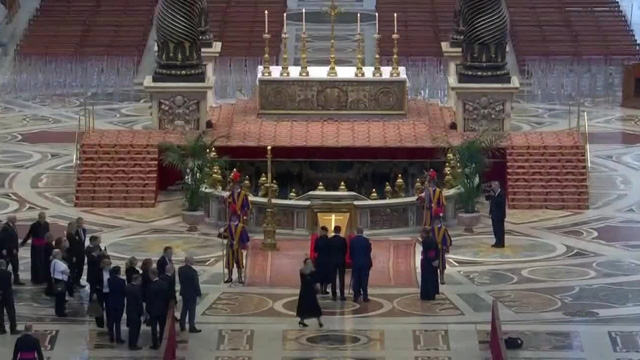Debate continues over localizer installation on concrete wall
입력 2025.01.01 (23:19)
읽어주기 기능은 크롬기반의
브라우저에서만 사용하실 수 있습니다.
[Anchor]
So, questions and controversies regarding the location, structure, and materials of the localizer facility continue.
The Ministry of Land, Infrastructure and Transport is maintaining a vague stance, stating that it will investigate the materials of localizers at other airports and review regulations further.
However, there are calls to focus not on regulations but on measures to eliminate the already identified risk factors.
Reporter Hwang Hyun-kyu has the story.
[Report]
The Jeju Air plane collided with this localizer after landing.
Debris from the broken passenger plane is scattered around the localizer mound.
The localizer at Muan Airport is made of a mound of earth measuring 40m in width, 4m in length, and 2m in height, with concrete inside and on top, and it is presumed that there was significant impact on the passenger plane at the time of the accident.
[Byun Soon-cheol/Former Head of the Aviation Investigation Team, Ministry of Land, Infrastructure and Transport/Dec. 30, 2024/KBS News 9: "When the aircraft collided with the localizer, it must have been at a very high speed. It was completely destroyed upon impact with the mound, and I believe that aspect needs to be investigated thoroughly."]
The Ministry of Land, Infrastructure and Transport has explained that this localizer installed on a concrete mound does not violate regulations.
The Ministry insists that while there are regulations stating that localizers should be installed on supports that break easily upon impact, the localizer at Muan Airport is outside the safety area at the end of the runway, so it is not subject to those regulations.
However, with a binding notice stating that the safety area should be extended to include the localizer, the Ministry has been providing vague responses day after day.
[Ju Jong-wan/Director of Aviation Policy, Ministry of Land, Infrastructure and Transport: "We will comprehensively review cases from foreign airports, including those from the International Civil Aviation Organization (ICAO) and major developed countries, and provide a separate explanation as soon as possible."]
Experts point out that even if there are no regulatory issues, improvements are necessary given the confirmed risks.
[Jeong Yoon-sik/Professor of Aviation Operations, Catholic Kwandong University: "This is not the time to debate regulations. If the regulations do not match the current situation or need to be improved, they should be revised effectively."]
The Ministry of Land, Infrastructure and Transport has announced that it will conduct an investigation into the materials of localizers installed at airports nationwide.
KBS News, Hwang Hyun-kyu.
So, questions and controversies regarding the location, structure, and materials of the localizer facility continue.
The Ministry of Land, Infrastructure and Transport is maintaining a vague stance, stating that it will investigate the materials of localizers at other airports and review regulations further.
However, there are calls to focus not on regulations but on measures to eliminate the already identified risk factors.
Reporter Hwang Hyun-kyu has the story.
[Report]
The Jeju Air plane collided with this localizer after landing.
Debris from the broken passenger plane is scattered around the localizer mound.
The localizer at Muan Airport is made of a mound of earth measuring 40m in width, 4m in length, and 2m in height, with concrete inside and on top, and it is presumed that there was significant impact on the passenger plane at the time of the accident.
[Byun Soon-cheol/Former Head of the Aviation Investigation Team, Ministry of Land, Infrastructure and Transport/Dec. 30, 2024/KBS News 9: "When the aircraft collided with the localizer, it must have been at a very high speed. It was completely destroyed upon impact with the mound, and I believe that aspect needs to be investigated thoroughly."]
The Ministry of Land, Infrastructure and Transport has explained that this localizer installed on a concrete mound does not violate regulations.
The Ministry insists that while there are regulations stating that localizers should be installed on supports that break easily upon impact, the localizer at Muan Airport is outside the safety area at the end of the runway, so it is not subject to those regulations.
However, with a binding notice stating that the safety area should be extended to include the localizer, the Ministry has been providing vague responses day after day.
[Ju Jong-wan/Director of Aviation Policy, Ministry of Land, Infrastructure and Transport: "We will comprehensively review cases from foreign airports, including those from the International Civil Aviation Organization (ICAO) and major developed countries, and provide a separate explanation as soon as possible."]
Experts point out that even if there are no regulatory issues, improvements are necessary given the confirmed risks.
[Jeong Yoon-sik/Professor of Aviation Operations, Catholic Kwandong University: "This is not the time to debate regulations. If the regulations do not match the current situation or need to be improved, they should be revised effectively."]
The Ministry of Land, Infrastructure and Transport has announced that it will conduct an investigation into the materials of localizers installed at airports nationwide.
KBS News, Hwang Hyun-kyu.
■ 제보하기
▷ 카카오톡 : 'KBS제보' 검색, 채널 추가
▷ 전화 : 02-781-1234, 4444
▷ 이메일 : kbs1234@kbs.co.kr
▷ 유튜브, 네이버, 카카오에서도 KBS뉴스를 구독해주세요!
- Debate continues over localizer installation on concrete wall
-
- 입력 2025-01-01 23:19:25

[Anchor]
So, questions and controversies regarding the location, structure, and materials of the localizer facility continue.
The Ministry of Land, Infrastructure and Transport is maintaining a vague stance, stating that it will investigate the materials of localizers at other airports and review regulations further.
However, there are calls to focus not on regulations but on measures to eliminate the already identified risk factors.
Reporter Hwang Hyun-kyu has the story.
[Report]
The Jeju Air plane collided with this localizer after landing.
Debris from the broken passenger plane is scattered around the localizer mound.
The localizer at Muan Airport is made of a mound of earth measuring 40m in width, 4m in length, and 2m in height, with concrete inside and on top, and it is presumed that there was significant impact on the passenger plane at the time of the accident.
[Byun Soon-cheol/Former Head of the Aviation Investigation Team, Ministry of Land, Infrastructure and Transport/Dec. 30, 2024/KBS News 9: "When the aircraft collided with the localizer, it must have been at a very high speed. It was completely destroyed upon impact with the mound, and I believe that aspect needs to be investigated thoroughly."]
The Ministry of Land, Infrastructure and Transport has explained that this localizer installed on a concrete mound does not violate regulations.
The Ministry insists that while there are regulations stating that localizers should be installed on supports that break easily upon impact, the localizer at Muan Airport is outside the safety area at the end of the runway, so it is not subject to those regulations.
However, with a binding notice stating that the safety area should be extended to include the localizer, the Ministry has been providing vague responses day after day.
[Ju Jong-wan/Director of Aviation Policy, Ministry of Land, Infrastructure and Transport: "We will comprehensively review cases from foreign airports, including those from the International Civil Aviation Organization (ICAO) and major developed countries, and provide a separate explanation as soon as possible."]
Experts point out that even if there are no regulatory issues, improvements are necessary given the confirmed risks.
[Jeong Yoon-sik/Professor of Aviation Operations, Catholic Kwandong University: "This is not the time to debate regulations. If the regulations do not match the current situation or need to be improved, they should be revised effectively."]
The Ministry of Land, Infrastructure and Transport has announced that it will conduct an investigation into the materials of localizers installed at airports nationwide.
KBS News, Hwang Hyun-kyu.
So, questions and controversies regarding the location, structure, and materials of the localizer facility continue.
The Ministry of Land, Infrastructure and Transport is maintaining a vague stance, stating that it will investigate the materials of localizers at other airports and review regulations further.
However, there are calls to focus not on regulations but on measures to eliminate the already identified risk factors.
Reporter Hwang Hyun-kyu has the story.
[Report]
The Jeju Air plane collided with this localizer after landing.
Debris from the broken passenger plane is scattered around the localizer mound.
The localizer at Muan Airport is made of a mound of earth measuring 40m in width, 4m in length, and 2m in height, with concrete inside and on top, and it is presumed that there was significant impact on the passenger plane at the time of the accident.
[Byun Soon-cheol/Former Head of the Aviation Investigation Team, Ministry of Land, Infrastructure and Transport/Dec. 30, 2024/KBS News 9: "When the aircraft collided with the localizer, it must have been at a very high speed. It was completely destroyed upon impact with the mound, and I believe that aspect needs to be investigated thoroughly."]
The Ministry of Land, Infrastructure and Transport has explained that this localizer installed on a concrete mound does not violate regulations.
The Ministry insists that while there are regulations stating that localizers should be installed on supports that break easily upon impact, the localizer at Muan Airport is outside the safety area at the end of the runway, so it is not subject to those regulations.
However, with a binding notice stating that the safety area should be extended to include the localizer, the Ministry has been providing vague responses day after day.
[Ju Jong-wan/Director of Aviation Policy, Ministry of Land, Infrastructure and Transport: "We will comprehensively review cases from foreign airports, including those from the International Civil Aviation Organization (ICAO) and major developed countries, and provide a separate explanation as soon as possible."]
Experts point out that even if there are no regulatory issues, improvements are necessary given the confirmed risks.
[Jeong Yoon-sik/Professor of Aviation Operations, Catholic Kwandong University: "This is not the time to debate regulations. If the regulations do not match the current situation or need to be improved, they should be revised effectively."]
The Ministry of Land, Infrastructure and Transport has announced that it will conduct an investigation into the materials of localizers installed at airports nationwide.
KBS News, Hwang Hyun-kyu.
-
-

황현규 기자 help@kbs.co.kr
황현규 기자의 기사 모음
-
이 기사가 좋으셨다면
-
좋아요
0
-
응원해요
0
-
후속 원해요
0










![[속보] 민주당 호남 경선, 이재명 88.69%, <br>김경수 3.9%, 김동연 7.41%](/data/layer/904/2025/04/20250426_A8AzXV.jpg)
![[속보] 인제 산불 대응 ‘산불 2단계’로 격상…강풍으로 진화에 어려움](/data/layer/904/2025/04/20250426_AtSEDi.jpg)



이 기사에 대한 의견을 남겨주세요.